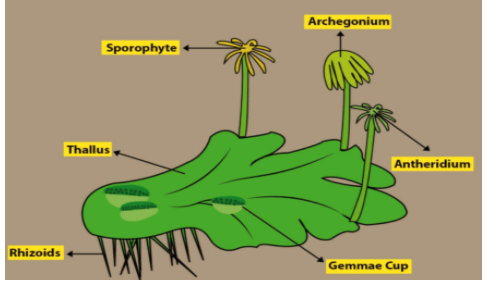
Examine the given figure and select the correct options giving all the four parts(a, b, c, d) correctly identified.

A) A-Seta, B-Sporophyte, C-Protonema, D-Rhizoids
B) A- Antheridiophore, B-Male thallus, C-Globules, D-Roots
C) A-Archegoniophore, B-Female thallus, C-Bud, D-Foot
D) A-Archegoniophore, B-Female thallus, C-Gemma cup, D-Rhizoids

Answer
513.9k+ views
Hint: The given figure is of Marchantia which is a bryophyte. Bryophytes are known to be small plants that are non-vascular and do not produce flowers or seeds and instead reproduce by the formation of spores.
Complete answer:
Marchantia is composed of two layers- an upper photosynthetic layer and a lower layer that serves for storage. It consists of a thallus containing tiny structure known as Gemma cups used for asexual reproduction. Rhizoids are present on the ventral surface of the thallus which are unicellular. Marchantia is known to reproduce both sexually and asexually. Asexual reproduction occurs with the help of Gemma cups.
Asexual reproduction also takes place when older plant parts die and new survivor branches develop into new plants. Sexual reproduction takes place with the help of sperm from antheridium and ovum in the archegonium. The antheridia and archegonia are in turn borne on the antheridiophore and archegoniophore. On fertilization a sporophyte is formed that gives rise to spores. The parts of
Marchantia with labelling are given below.

So the correct option is D) A-archegoniophore, B-Female thallus, C-Gemma cup, D-Rhizoids
Note: Marchantia is found worldwide and requires moist soil and damp rocks for their growth. They are mostly found on river and pool banks, fens and dune slacks. It is also found in man made habitats such as gardens and greenhouses.
Complete answer:
Marchantia is composed of two layers- an upper photosynthetic layer and a lower layer that serves for storage. It consists of a thallus containing tiny structure known as Gemma cups used for asexual reproduction. Rhizoids are present on the ventral surface of the thallus which are unicellular. Marchantia is known to reproduce both sexually and asexually. Asexual reproduction occurs with the help of Gemma cups.
Asexual reproduction also takes place when older plant parts die and new survivor branches develop into new plants. Sexual reproduction takes place with the help of sperm from antheridium and ovum in the archegonium. The antheridia and archegonia are in turn borne on the antheridiophore and archegoniophore. On fertilization a sporophyte is formed that gives rise to spores. The parts of
Marchantia with labelling are given below.

So the correct option is D) A-archegoniophore, B-Female thallus, C-Gemma cup, D-Rhizoids
Note: Marchantia is found worldwide and requires moist soil and damp rocks for their growth. They are mostly found on river and pool banks, fens and dune slacks. It is also found in man made habitats such as gardens and greenhouses.
Recently Updated Pages
Master Class 11 Economics: Engaging Questions & Answers for Success

Master Class 11 English: Engaging Questions & Answers for Success

Master Class 11 Social Science: Engaging Questions & Answers for Success

Master Class 11 Biology: Engaging Questions & Answers for Success

Class 11 Question and Answer - Your Ultimate Solutions Guide

Master Class 11 Business Studies: Engaging Questions & Answers for Success

Trending doubts
What is meant by exothermic and endothermic reactions class 11 chemistry CBSE

10 examples of friction in our daily life

One Metric ton is equal to kg A 10000 B 1000 C 100 class 11 physics CBSE

Difference Between Prokaryotic Cells and Eukaryotic Cells

What are Quantum numbers Explain the quantum number class 11 chemistry CBSE

1 Quintal is equal to a 110 kg b 10 kg c 100kg d 1000 class 11 physics CBSE




